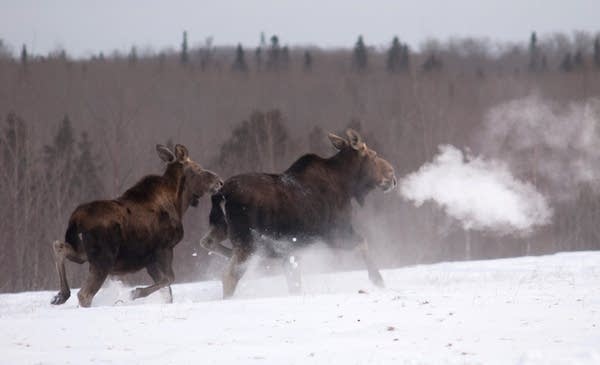Minnesota’s moose count holds steady, but they’re not out of the woods

Go Deeper.
Create an account or log in to save stories.
Like this?
Thanks for liking this story! We have added it to a list of your favorite stories.
Minnesota’s moose population has stabilized over the past decade but climate change, predators and parasites continue to put the creatures at risk, the latest state Department of Natural Resources survey shows.
The annual winter survey, conducted from mid-January to early February in northeastern Minnesota, estimated 3,470 moose in the region. That’s consistent with estimates over the past several years ranging from around 3,300 moose last year, to 4,700 in 2022.
Based on aerial surveys and research over the past 15 years, the DNR said it was reasonably confident the northeastern Minnesota moose population had “more-or-less stabilized at around 3,700 moose” following steep declines between 2009 and 2013.
The most recent peak came in 2006 when the DNR estimated the state’s moose population at 8,840.
Turn Up Your Support
MPR News helps you turn down the noise and build shared understanding. Turn up your support for this public resource and keep trusted journalism accessible to all.
Despite the stabilizing counts, DNR officials and other researchers say moose in the state remain at risk given long-term trends.

Researchers including Mike Schrage, a wildlife biologist with the Fond du Lac Band of Lake Superior Chippewa, say climate change, parasites, and predation on moose calves by predators including wolves and bear have all played a role in the moose decline.
While the trends signal a stable population between 3,000 and 4,000, “I think the long term is uncertain,” said Schrage, who helped conduct the winter survey. “The biggest uncertainty there is climate change, and what’s that going to do the forest and moose numbers in the future.”
The Fond du Lac Band and the 1854 Treaty Authority contributed funding and personnel for the 2024 annual survey, which was delayed about 10 days because of the lack of snow around the survey area in the Arrowhead region.
Researchers fly overhead to count the moose, but they can be difficult to count without significant snow on the ground — dark brown moose are much easier to spot from overhead against a white, snowy backdrop.
“I don’t think we were expecting any significant changes this year,” Schrage said of this year’s results. “It’s still a little frustrating. We’d like to see moose numbers going up. But you know, it’s better than going in the other direction.”
Dear reader,
Political debates with family or friends can get heated. But what if there was a way to handle them better?
You can learn how to have civil political conversations with our new e-book!
Download our free e-book, Talking Sense: Have Hard Political Conversations, Better, and learn how to talk without the tension.




